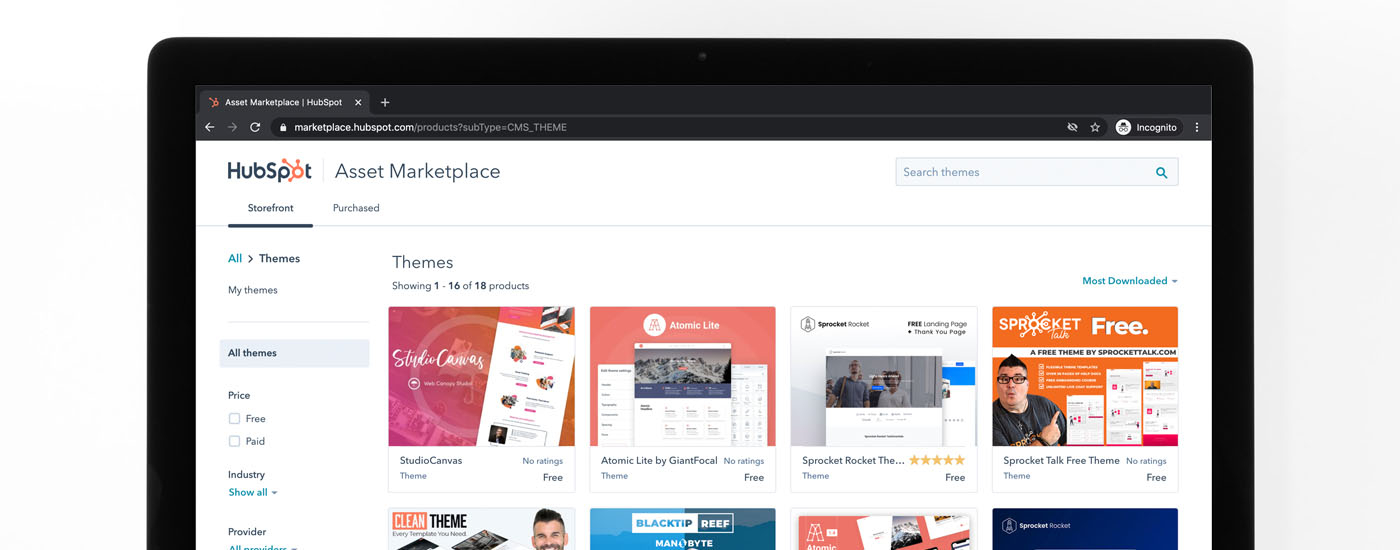3 Tips for Anyone Building Themes for the Template Marketplace
 When it comes to successfully selling themes in HubSpot's Template Marketplace, building a quality product is just part of the challenge. You'll also need to put some thought into your pricing strategy, audience, and positioning to ensure your theme stands out from other options and achieves as many downloads as possible. Here are three tips to help you get started:
When it comes to successfully selling themes in HubSpot's Template Marketplace, building a quality product is just part of the challenge. You'll also need to put some thought into your pricing strategy, audience, and positioning to ensure your theme stands out from other options and achieves as many downloads as possible. Here are three tips to help you get started:
Tip #1: Consider listing your themes as “free” in the marketplace
Building a quality theme takes significant time and effort. So why should you consider listing your creation as “free” in the Template Marketplace, when you could potentially sell it for hundreds of dollars per download?
Under the right circumstances, this isn't as crazy as it sounds. Free themes are downloaded way more often in the marketplace than paid themes, so by using a freemium strategy, you may ultimately make more money than if you charge for every download.
Here are some approaches we have seen work well for providers:
Use a free theme to up-sell paid themes with more features
People like to try things before they buy them. This is especially true when it comes to website designs. It's intimidating to drop several hundred dollars on a theme when you aren't sure if it will end up being a good fit for your business needs.
You can help users get past this hesitation by creating two versions of your theme: a simple free version that gives a taste of how everything works, and a premium paid version that includes more assets and functionality. Once people download your free theme, you can promote the paid version to them.
Use your free theme to sell web development services
Once customers download your theme, there is a good chance they may need some customizations to make it fit their exact needs. If you are a web developer or web agency, this is a perfect opportunity to offer your services and win new clients. Because you built the theme, you know it inside and out and have an advantage offering your expertise.
While you can do this with any theme, free and low-cost themes will attract more downloads, and therefore more visibility for your services. When considering this strategy, it is a good idea to estimate how much it will cost you to create a theme vs. the average value of a new customer so you can figure out the potential ROI over time.
Tip #2: Make sure your theme offers value to CMS Hub and Marketing Hub customers
HubSpot offers several different products for sales, service, and marketing professionals. This includes CMS Hub, a powerful content management system that allows customers to build and host complete websites. It also includes Marketing Hub, a set of tools for professional marketers that helps users create standalone blogs and landing pages.
Themes can be used in both of these products, giving non-technical content creators the ability to create and modify web pages via a drag-and-drop interface. It is important to design your theme to appeal to both of these audiences, and not just CMS users. Keep in mind that Marketing Hub is our original hub, and has a very large audience.
For CMS Hub customers building complete websites, you'll want to include page templates, system pages, and more. Marketing Hub customers won't need all of those assets, but they will be looking for various landing pages, thank-you pages, and blog listing templates (single column posts, posts with sidebar, and 2 column posts), etc.
By taking into account all of our customers looking for the drag-and-drop web page functionality themes provide, you can maximize the number of downloads you receive and increase your ROI. It's worth the additional effort.
Tip #3: Be intentional about your target audience
Before you begin building themes, start by outlining who the ideal users will be. This will help you make strategic design decisions and will be a crucial part of differentiating your theme from other options available in the marketplace. Here are a few things you should consider:
- Is this theme intended for B2B or B2C organizations?
- What will the overall aesthetic be? (for example: friendly, professional, modern)
- What industries will this theme cover? Etc.
While building a flexible theme will allow users to shape it for their specific needs, the placeholder images and copy you include will significantly impact how potential buyers perceive your theme. It is much easier to visualize using a theme that already fits your business. Use this to position yourself for success.
HubSpot customers come from a wide range of backgrounds, and while we can’t provide any specific data about our users, here is a list to provide some inspiration on industries you might consider targeting:
|
|
But this list is by no means exhaustive. If you have a strong vision for a different set of users, go for it. You may be able to benefit by being the first to offer a theme for a particular industry.
Final thoughts
Hopefully, these tips will help you approach your theme strategically and maximize the number of downloads you receive in the marketplace. These recommendations are not hard and fast rules. Instead, we hope they provide inspiration as you figure out the best approach for your specific team and project.
Happy building!